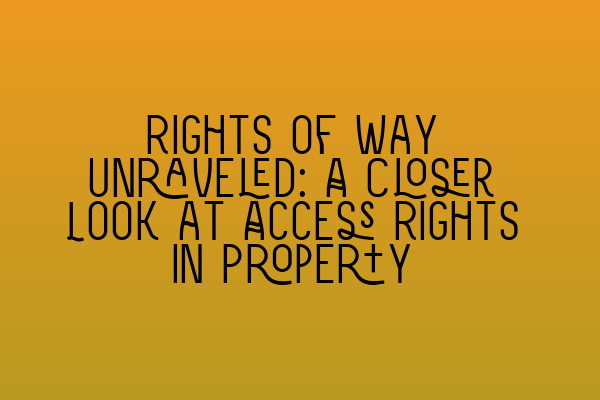Rights of Way Unraveled: A Closer Look at Access Rights in Property
Welcome to SQE Property Law & Land Law! As solicitors specializing in property law, we understand the importance of access rights in relation to land. In this blog post, we will delve deeper into the concept of rights of way, shedding light on its intricacies and providing you with a comprehensive understanding of this crucial aspect of property ownership.
What are Rights of Way?
Rights of way refer to the legal rights an individual or entity has to pass over another person’s property for a specified purpose. These rights can be granted in various forms, including express grants, implied grants, and statutory rights. Understanding the different types of rights of way is essential, as it can determine the extent of your access to a particular property.
Types of Rights of Way
1. Prescriptive Rights of Way:
Prescriptive rights of way are acquired through long and uninterrupted use of a pathway or route without the need for an official grant. This type of right of way can only be claimed if the use has been continuous and enjoyed without objection for a specified period, typically 20 years. It is important to note that prescriptive rights of way can be a contentious issue, often resulting in legal disputes. To avoid such conflicts, it is advisable to seek legal counsel to ensure the legitimacy of any claimed rights.
2. Easements:
Easements are legally recognized rights over another person’s land, allowing the holder of the easement to use the land for a specific purpose. Common examples of easements include the right to access public utilities, such as water and electricity, running through someone else’s property. Easements can be created through express agreements, implied agreements, or by necessity.
3. Public Rights of Way:
Public rights of way are paths or routes that are legally designated for public use. These rights of way can take various forms, such as footpaths, bridleways, and byways. Public rights of way are often marked by signage or shown on official maps. They are maintained by local authorities and are accessible to the general public. It is worth noting that public rights of way can be subject to restrictions and limitations, so it is crucial to familiarize yourself with any applicable regulations or bylaws.
How to Protect and Enforce your Rights of Way?
Protecting and enforcing your rights of way can be a complex task, requiring a solid understanding of property law. As property law specialists, we recommend the following steps to safeguard your access rights:
1. Document and Register:
Ensure that any contractual agreements or grants pertaining to rights of way are properly documented and registered. This will provide you with the necessary evidence to assert your rights in the future.
2. Regular Maintenance:
Regularly maintain the route or pathway subject to your rights of way. This includes clearing vegetation, repairing any damage, and ensuring that the path remains accessible and safe for use.
3. Seek Legal Advice:
If you encounter any issues or disputes regarding your rights of way, it is crucial to seek legal advice from experienced property law solicitors. They can guide you through the legal process, negotiate with the parties involved, and ultimately protect your rights.
Conclusion
Access rights in property, particularly rights of way, play a vital role in ensuring that individuals and entities have the necessary access to their land. Whether it’s a prescriptive right, an easement, or a public right of way, understanding the different types of access rights is essential for property owners.
At SQE Property Law & Land Law, we are experts in all aspects of property law, including rights of way. If you have any questions or need assistance with protecting or enforcing your access rights, please do not hesitate to contact us. You can also explore our other articles for further insights into related topics, such as Understanding Contractual Capacity: Rights and Limitations, Interactive SQE Mock Tests for Contract Law: Test Your Knowledge, Join Our SQE Contract Law Webinars: Expert Insights and Guidance, Contractual Capacity: Understanding Legal Competence in Contracting Parties, and Contract Law Reforms: An Analysis of Recent Changes.
Remember, knowledge is power, and understanding your rights of way is key to successful property ownership. Stay informed and stay protected.
